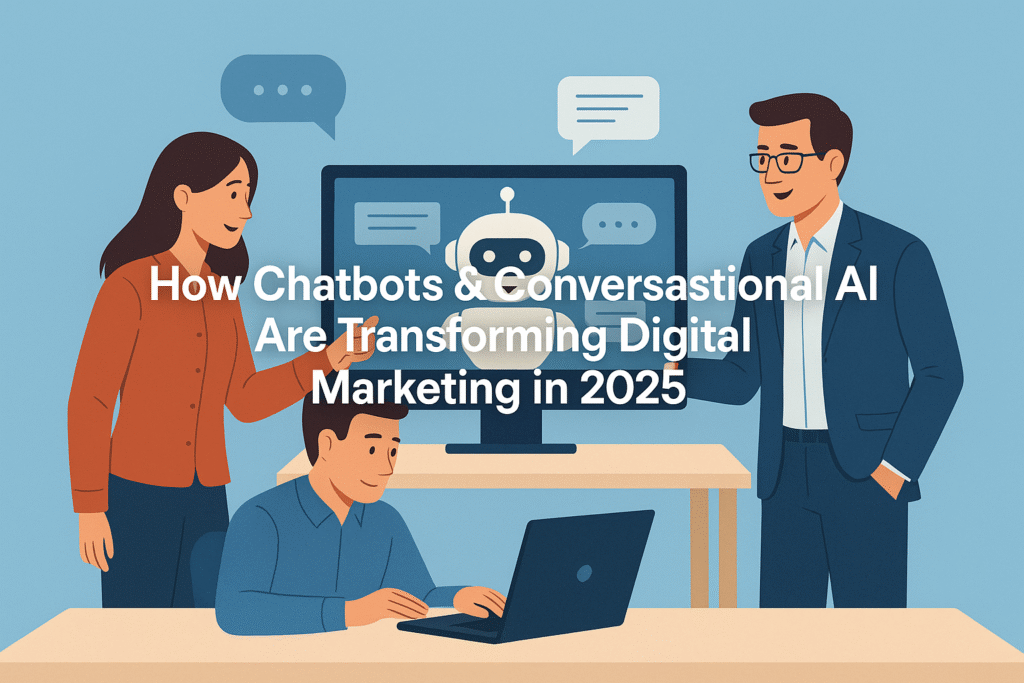
Introduction
Digital marketing is evolving faster than ever, and businesses are now looking beyond traditional campaigns to create real-time, personalized customer experiences. Enter chatbots and conversational AI—two of the most transformative tools in the marketer’s toolkit today.
From 24/7 customer service to automated lead generation and instant engagement, chatbots are redefining how brands communicate online. In 2025, their role isn’t just about answering questions—it’s about driving conversions, boosting satisfaction, and shaping the entire customer journey.
Understanding Chatbots & Conversational AI
What Are Chatbots?
Chatbots are computer programs designed to simulate conversation with users. They can be rule-based (using pre-set responses) or AI-powered (using natural language processing – NLP – to understand context and intent).
What Is Conversational AI?
Conversational AI goes beyond pre-programmed scripts. It uses advanced machine learning models to interpret user intent, learn from past interactions, and respond in human-like ways.
Their Growing Role
In digital marketing, both tools serve as front-line brand ambassadors—answering queries, nurturing leads, and personalizing experiences across websites, social media, and messaging apps.
Did you know? By 2025, nearly 95% of customer interactions will be AI-powered (Fullview.io).
Why They Matter for Digital Marketing
Chatbots and conversational AI are reshaping how marketers engage with audiences. Here’s why they’re essential:
- Instant Engagement: No waiting time—visitors get immediate responses.
- Scalability: Handle thousands of queries simultaneously.
- Personalization: Leverage user data for tailored suggestions and product recommendations.
- Data Insights: Each chat provides valuable data on behavior and preferences.
- Voice & AEO Integration: Conversational AI supports voice search queries (“How can I contact customer service?”).
For small and mid-sized businesses, these tools bridge the gap between human touch and automation—offering high-quality engagement at a fraction of traditional marketing costs.
Key Use Cases in Digital Marketing
1. Lead Generation & Qualification
Chatbots qualify visitors by asking targeted questions—“What service are you interested in?” or “What’s your budget range?”—and passing hot leads directly to sales teams.
2. Personalized Customer Experience
AI learns from previous interactions to provide personalized offers, recommendations, or reminders that match each user’s behavior.
3. Omnichannel Engagement
Chatbots operate across platforms—website, WhatsApp, Facebook Messenger, Instagram DMs—ensuring consistent brand interaction.
4. Interactive Content Delivery
Businesses now share quizzes, videos, and blog links directly through bots, creating an immersive marketing funnel.
5. Voice Search & Conversational Queries
Chatbots optimized for voice queries respond naturally to spoken requests such as:
“How can I get a quote for digital marketing services?”
This helps improve visibility in voice-search rankings and answer engines.
Benefits & Impact
- 24/7 Availability: Customers get instant help anytime, anywhere.
- Higher Conversion Rates: Personalized, timely responses move users through the funnel faster.
- Improved ROI: Chatbots reduce support costs while driving engagement.
- Enhanced Data Collection: Every interaction helps refine marketing messages.
💡 According to industry reports, 74% of brands report improved customer satisfaction after deploying chatbots.
How to Integrate Chatbots & Conversational AI into Your Digital Marketing Strategy
1. Define Your Objectives
Decide whether your bot will:
- Generate leads
- Provide support
- Deliver product recommendations
- Gather feedback
2. Choose the Right Platform
Popular chatbot tools include Intercom, Drift, ManyChat, and HubSpot Chatbot Builder. Select one that integrates seamlessly with your CRM and website.
3. Design the Conversation Flow
Map common questions and responses. Use a friendly tone, add emojis for warmth, and ensure easy escalation to a human agent if needed.
4. Align with Your Marketing Funnel
At the top, bots can attract visitors. In the middle, they can nurture leads. At the bottom, they can push conversions with offers or scheduling options.
5. Measure & Optimize
Track metrics like:
- Average response time
- Conversion rate
- Lead quality
- User satisfaction
Refine scripts using A/B testing to continually improve performance.
6. Build Trust & Transparency
Always disclose when users are chatting with a bot. Provide data privacy details and an easy human-help option. This fosters long-term trust.
Best Practices for Chatbot Success
- Use voice-friendly phrases—many users interact through voice assistants.
- Keep responses short, clear, and conversational.
- Integrate chatbot analytics with your marketing dashboard.
- Localize for regional audiences and languages.
- Continuously train your AI with updated FAQs and new user data.
- Don’t over-automate—balance efficiency with human empathy.
Common Mistakes to Avoid
- Launching without a clear purpose or audience strategy.
- Overloading users with robotic or irrelevant responses.
- Ignoring feedback and data metrics.
- Using the bot as a complete human replacement.
- Neglecting voice search and answer-engine optimization.
Future Trends to Watch
- GPT-powered conversational agents delivering more natural dialogues.
- Proactive bots that reach out based on predictive insights.
- Voice-first experiences blending chatbots with smart speakers.
- Emotionally intelligent bots recognizing tone and sentiment.
- Ethical AI focus—transparency, consent, and responsible data use.
Conclusion
Chatbots and conversational AI are no longer futuristic—they’re fundamental. They allow businesses to scale customer interactions, personalize marketing at scale, and generate valuable insights.
When integrated thoughtfully into your digital marketing ecosystem, these tools boost efficiency, engagement, and conversions while freeing your team to focus on creative strategy.
🌟 Action Step: Start by implementing a chatbot on your homepage or social media channel and watch your engagement and lead flow grow!
FAQs
1. What’s the difference between a chatbot and conversational AI?
Chatbots follow rules; conversational AI understands intent and learns from data to hold natural dialogues.
2. How much does it cost to implement a chatbot?
Depending on features, costs range from $30/month (basic) to $1,000+/month (enterprise AI).
3. Can chatbots replace human marketers?
No—chatbots amplify human effort by automating repetitive tasks, not creativity or empathy.
4. How do chatbots impact voice search optimization?
They help brands capture question-based queries common in voice searches by structuring conversational responses.
5. What metrics should I track?
Conversion rates, engagement time, satisfaction scores, and lead quality are the most insightful KPIs.

